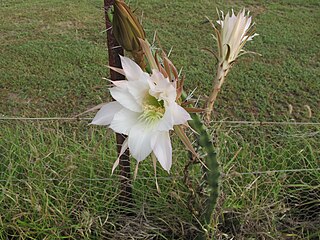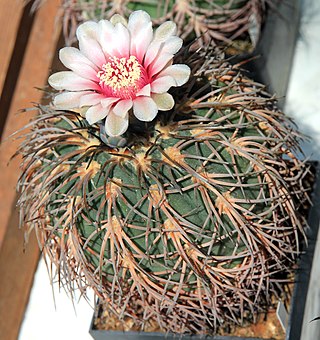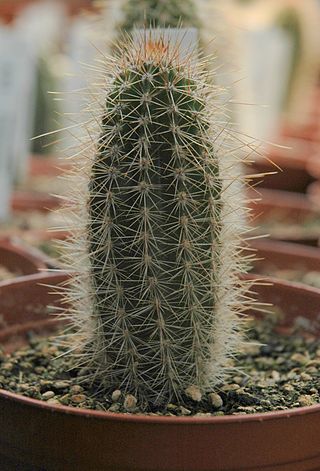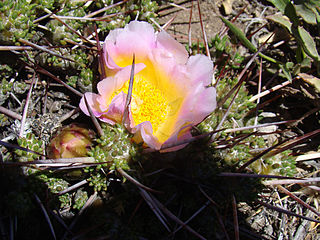
Quiabentia zehntneri is a species of plant in the family Cactaceae. It is endemic to Brazil. Its natural habitats are subtropical or tropical dry forests and subtropical or tropical dry shrubland. It is threatened by habitat loss. Common names are “Quiabento”, “Flor de Cera” and “Espinho de São Antonio”.

Ferocactus echidne is a barrel cactus in the genus Ferocactus. It is found in nature in Mexico. This cactus is known commonly as Sonora barrel, Coville's barrel cactus, Emory's barrel cactus, and traveler's friend. This plant is often sold as a houseplant.

Harrisia aboriginum, the west-coast prickly apple or prickly applecactus, is a species of columnar cactus endemic to peninsular Florida, on the Gulf Coast of the counties of Lee, Sarasota County, and Charlotte. Only 12 occurrences are known, and the species is threatened by horticultural collection, shading from fire suppression, competition from invasive flora, and most of all habitat destruction. It is a federally listed endangered species of the United States.
Harrisia gracilis is a species of cactus found in Jamaica.

Harrisia martinii, commonly called the Martin applecactus, is a species of night-blooming, rope-like cacti native to South America. With large showy flowers that attract the hawk moth, it is considered by some a useful landscape plant in areas that do not freeze.

Harrisia pomanensis is a species of cactus.

Harrisia tortuosa is a species of cactus in the Trichocereeae tribe.

Gymnocalycium spegazzinii is a species of Gymnocalycium from Argentina and Bolivia named after the botanist C. L. Spegazzini.

Armatocereus cartwrightianus is a species of Armatocereus from Ecuador and Peru.

Armatocereus godingianus is a species of Armatocereus from Ecuador and Peru.

Echinopsis aurea, is a species of Echinopsis found in Argentina.

Lobivia pampana is a species of Lobivia found in Peru.

Maihuenia patagonica, commonly known locally as chupasangre or siempre verde, is a succulent cactus shrub native to Chile and Argentina. Maihueniapatagonica is remarkably tolerant to moisture and cold temperatures.

Cleistocactus smaragdiflorus is a species of Cleistocactus found in Bolivia and Argentina.

Melocactus bahiensis is a species of Melocactus found in Bahia, Brazil.

Matucana haynii is a species of Matucana found in Peru.

Harrisia brookii is a species of cactus found in the Bahamas.

Pelecyphora chihuahuensis is a species of flowering plant in the family Cactaceae, native to Mexico.

Harrisia eriophora is a species of cactus found in Cuba.

Borzicactus sepium is a species of Borzicactus found in Ecuador.



















